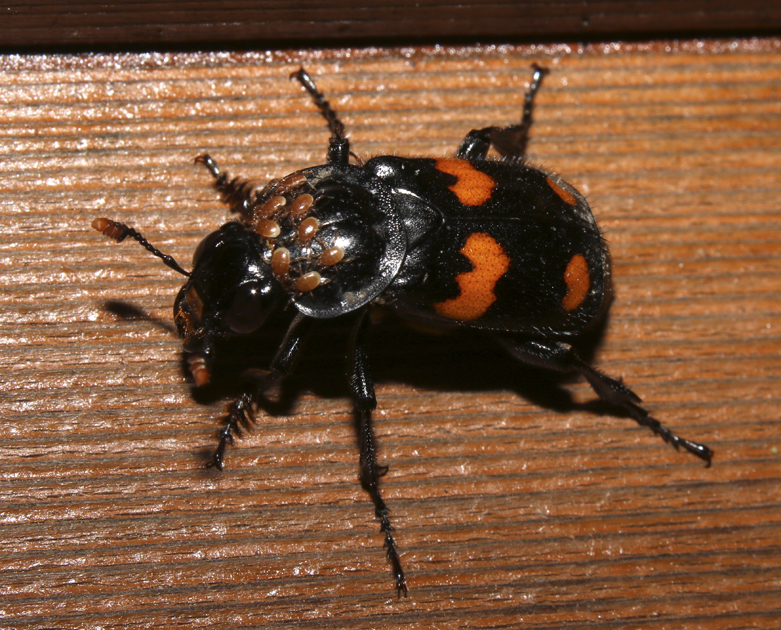
Eggs soon hatch into larvae, youthful champions at consuming shreds of protein-rich flesh and internal organs of the deceased. As they graze on the fleshy bounty, adult beetles occasionally deposit eggs in the soil near the carcass. Maggots are an important source of food for adult carrion beetles. Once colonized by blow flies, a dead animal will soon be writhing with maggots of flesh-eating flies. This honor belongs to blow flies which often discover a body within minutes of its demise. Carrion beetles are not usually the first to arrive at the carcass of a dead thing. Along with flies and other species of beetles, carrion beetles provide an important ecosystem service by recycling the protein found in the flesh of dead animals. Among the most prominent and abundant of these flesh eaters was Oiceoptoma noveboracense, commonly known as the margined carrion beetle.

Upon closer inspection, I discovered a well-developed ecosystem of necrophagous insects making the most of the decaying bounty provided by the deer in its final act. Several years ago while walking a field not far from a roadway traversing Etchison, Maryland, I noticed the earthly remains of a white-tailed deer resting in the tall grass, no doubt the unfortunate participant in an encounter with a vehicle on the nearby road. One answer to this question appears in the final resting place of recently expired deer, the deerly departed so to speak. With all the undesirable changes deer bring to the suburban landscape, what is the upside of this pariah? The growing tips of my hopeful sunflowers and blueberries are but a memory.

Small saplings bear the scars and deformities dealt by young bucks removing velvet from their antlers. During the winter, my pansies were pillaged and my once glorious azaleas were reduced to skeletal pickets of denuded branches presenting a few sad blossoms this spring. The grazing pressure of deer in my neighborhood has defeated all attempts at growing unprotected vegetables. Encroachment of human development on natural habitats put deer in contact with humans and their gardens. Long gone are the wild predators, mountain lions and wolves, that once kept burgeoning deer populations in check. When I see a dozen or so bedding down in my backyard, I think most of these rascals live in Columbia, Maryland. It is estimated that in the US, more than 20 million deer share the land with us.
CARRION BEETLE FULL
Full grown larvae move into the soil to pupate.Through no fault of their own, white-tailed deer are a major pest of ornamental plants in our suburban and rural landscapes. Adults protect and provision the larvae throughout their lives, eliminating competition from dipteral larvae etc. If there are too many larvae the adults will selectively cull them at an early age. Adults feed on the carrion and regurgitate liquid food in response to begging behaviour from the larvae, this is thought to speed larval development and also to help preserve the food. Eggs are laid in the soil and the newly hatched larvae move onto the carcass. is used to line and reinforce the burial chamber, and the complete process of burial may take eight hours. Before burial the carcass is rolled into a ball. Before burying the carcass they remove the fur or feathers and smear it with bactericide and fungicide to slow the decay and make it less attractive to other beetles and flies etc. The pair digs a depression beneath the carcass by pushing soil forward with their heads, if the soil is too hard they will move the carcass a short distance to more suitable substrate. Females can bury a carcass and raise larvae alone from sperm stored from previous matings. If a single male arrives at carrion it will wait for a partner to arrive they attract females by releasing a pheromone from the tip of the abdomen. Usually being attracted by the smell, a carcass will attract many individuals and the beetles will fight males with males and females likewise, for the right to bury and breed on the food source. Most species breed at small carcases of rodents and birds. They feed and breed on carrion and some species will breed communally on carrion too large to bury.

This is a Sexton Beetle or Burying Beetle in the genus Nicrophorus, possibly Nicrophorus interruptus which is pictured on UK Beetles where it states: “Nicrophorus species are unusual among beetles as they display biparental care of the larvae.


 0 kommentar(er)
0 kommentar(er)
